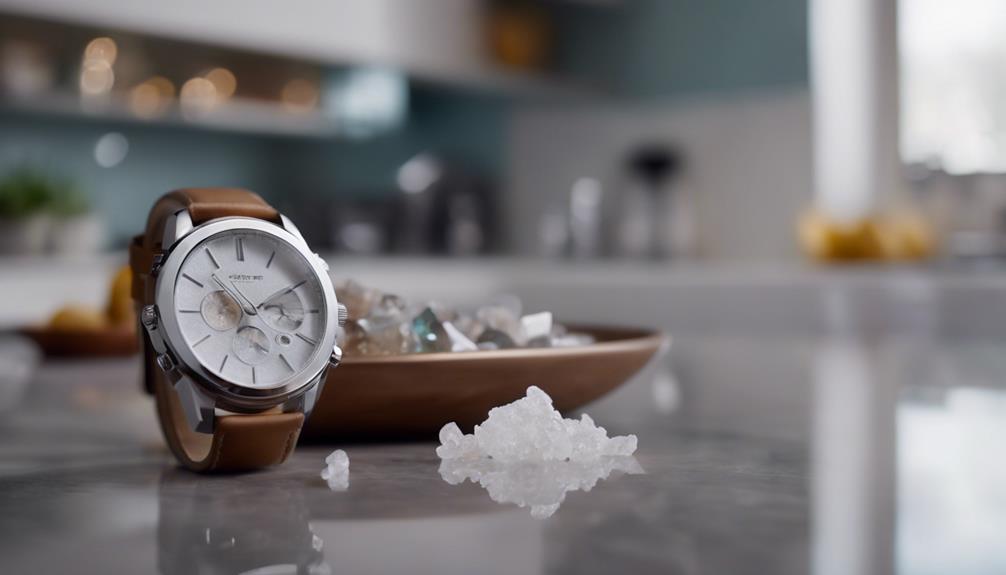Did you know that nearly 90% of the Earth’s crust is composed of silicate minerals, with quartz being one of the most abundant?
We often overlook the significance of this versatile mineral, despite its myriad uses across various industries.
From its role in the beauty of jewelry to its critical function in the technology and electronics sectors, quartz crystal’s applications are both fascinating and essential.

Its piezoelectric properties, for instance, revolutionized timekeeping, and that’s just the tip of the iceberg.
Let’s explore further how this seemingly ordinary mineral plays a part in our daily lives and the advanced technologies we rely on.
Key Takeaways
- Quartz is integral in electronics for precise timekeeping and frequency control.
- It plays a significant role in spiritual practices for energy amplification and balance.
- Utilized in scientific research for its piezoelectric properties and unique vibrational frequency.
- Essential in jewelry making for its durability and aesthetic appeal.
Jewelry and Gemstones
Quartz crystals, with their durable and lustrous qualities, have become a cornerstone in the creation of both timeless and innovative jewelry designs. We’ve observed that the hard and durable nature of quartz makes it an ideal candidate for crafting long-lasting and polishable jewelry pieces. Its inherent clarity and brilliance inject a touch of elegance into every design, enhancing the overall aesthetic appeal.
In our detailed analysis, we’ve found that the versatility of quartz in jewelry making is unparalleled. From the subtle hues of Rose Quartz to the deep purples of Amethyst, and the warm tones of Citrine to the refreshing greens of Aventurine, the palette available to designers is both rich and diverse. This versatility allows for the creation of pieces that can range from delicate and understated to bold and statement-making, catering to a wide array of preferences and styles.
Moreover, the vibrant colors and unique properties of quartz crystals have solidified their position as a favorite choice among jewelry makers, bridging the gap between traditional and contemporary design philosophies. It’s clear that the use of quartz in jewelry making not only celebrates the crystal’s natural beauty but also its ability to adapt and resonate within a multitude of design contexts.
Technology and Electronics
Moving beyond its aesthetic applications in jewelry, we find that quartz crystals play a pivotal role in the realm of technology and electronics, where their precise vibration frequencies are indispensable. Composed of silicon and oxygen atoms, these crystals are at the heart of quartz oscillators, fundamental components in ensuring the accuracy of electronic devices. Their piezoelectric properties, where pressure generates an electrical signal, are vital in the semiconductor industry, enabling the function of electronic circuits and sensors.
Quartz’s stability across diverse temperatures allows for precision calibration in devices crucial to telecommunications, aerospace, and automotive sectors. This adaptability ensures that our electronic equipment, from mobile phones to sophisticated aerospace systems, operates with unparalleled accuracy and reliability. In these fields, the reliance on quartz crystals isn’t just a matter of preference but of necessity, highlighting their integral role in the advancement of technology.
Furthermore, the fusion of quartz in technology extends to the production and enhancement of semiconductor devices. Its piezoelectric qualities are indispensable in creating components that respond to mechanical stress with electrical signals, a cornerstone for the development of sensors and actuators in various electronic equipment. This makes quartz an unsung hero in the technological landscape, powering innovations that drive our modern world.
Timekeeping Devices

In the realm of timekeeping devices, we’ve seen an unparalleled revolution through the incorporation of quartz crystals, whose piezoelectric properties facilitate precise frequency vibrations essential for accurate time measurement. This revolution in technology has bolstered the precision and reliability of devices we use every day. Here’s how quartz crystals have become indispensable in timekeeping:
- Quartz crystals ensure accurate timekeeping by vibrating at precise frequencies, thanks to their piezoelectric properties. This means our watches and clocks can keep time with remarkable accuracy.
- Quartz oscillators, powered by quartz crystals, provide stable electrical properties over a wide temperature range. This stability is crucial for the consistent operation of timekeeping devices, ensuring they function accurately regardless of environmental conditions.
- In watches and clocks, the integration of quartz crystals has revolutionized precision. These timekeeping devices rely on the consistent vibrations of quartz to regulate movement accurately.
- The technical superiority of quartz crystals in providing precise frequencies has thoroughly transformed the landscape of timekeeping devices. Their ability to maintain stable electrical properties has made them the backbone of modern timekeeping technology.
Through these mechanisms, quartz crystals have unequivocally revolutionized precision in timekeeping devices, making accurate timekeeping a standard in our daily lives.
Spiritual and Healing Practices
Beyond their pivotal role in timekeeping, we also harness the versatile attributes of quartz crystals within spiritual and healing practices, where they’re esteemed for their capacity to amplify energy and foster balance. Recognized as the Universal Crystal, these stones are integral to meditation, healing sessions, and protective rituals. Their inherent ability to balance and stabilize environments promotes an atmosphere of harmony and well-being, crucial for both physical and mental health.
Quartz crystals’ proficiency in amplifying healing energy allows practitioners to enhance mental and physical strength, making them indispensable in spiritual healing. The crystals’ unique vibrational frequency aids in elevating spiritual growth by channeling energies effectively, ensuring a connection between the physical and spiritual realms. This capability not only aids in meditation, allowing for deeper states of relaxation and awareness but also provides a shield against negative energies, ensuring protection for the user.
Their historical value underscores their effectiveness in enhancing well-being and fostering spiritual development. By amplifying energy and facilitating the effective channeling of energies, quartz crystals serve as powerful tools in achieving balance, harmony, and advancement in spiritual practices.
Industrial Applications

Quartz’s versatility extends into the industrial sector, where its unique properties are leveraged in various applications ranging from foundry work to precision timekeeping. This mineral’s significant roles are deeply embedded in industries that require materials with high purity, thermal stability, and specific mechanical properties.
The wide range of industrial applications includes:
- Foundry Industry: Quartz, in the form of high-purity silica sand, is used for molding sand in metal casting. It helps in removing impurities from molten metals, ensuring the production of high-quality castings.
- Refractory Industry: The production of heat-resistant bricks relies on quartz’s ability to withstand high temperatures. Its role as a flux in high-temperature metal smelting applications is also invaluable, enhancing the efficiency of the smelting process.
- Glass Industry: The intrinsic characteristics of quartz, such as its thermal stability and ability to transmit light, make it crucial for glassmaking. Its high purity ensures the production of clear and durable glass products.
- Precision Timekeeping: Quartz crystals exhibit piezoelectric properties, which are exploited in watches and clocks. These crystals vibrate at precise frequencies, regulating movement and ensuring accurate timekeeping.
Through these applications, quartz’s contribution to the industrial landscape is undeniable, highlighting its importance across multiple sectors.
Frequently Asked Questions
What Is Quartz Most Commonly Used For?
We’re often asked what quartz is most commonly used for. It’s the backbone of timekeeping accuracy, pivotal in glass manufacturing, semiconductor fabrication, and enhancing optical lenses. Additionally, it’s found in gemstone jewelry and kitchen countertops.
What Is the Main Purpose of Quartz?
We’ve found that quartz’s main purpose lies in its diverse applications, including quartz watches, silicon chips, and optical lenses. It’s essential for frequency standards, piezoelectric devices, gemstone carving, glass making, and even crystal healing.
What Is Quartz Best For?
We’ve discovered quartz’s quintessential qualities across various ventures, excelling in electronic circuits for timekeeping accuracy, enhancing glass manufacturing, crafting exquisite jewelry, advancing healing practices, contributing to abrasive materials, perfecting optical instruments, and enriching paint additives as UV-resistant materials.
What Does Clear Quartz Do Spiritually?
We’ve found that clear quartz aids spiritual growth by amplifying energy, aligning chakras, and cleansing auras. It’s a key tool for meditation, emotional healing, and enhancing intuition, expanding consciousness, and developing psychic abilities through vibrational balancing.
Conclusion:What Is Quartz Crystal Used For?
In sum, we’ve explored the multifaceted uses of quartz crystal, from adorning our bodies with its beauty as jewelry to enhancing our technological devices.
We’ve seen how it keeps our time precise and supports our spiritual healing.
Quartz’s role in industrial processes further underscores its versatility and strength.
Through analysis, we recognize quartz as not just a mineral, but a cornerstone in various fields, embodying resilience, precision, and innovation.
Its contributions are vast, rendering quartz indispensable in our modern world.






Leave a Reply